A Guide to Autism Treatments: ABA vs Occupational Therapy
When it comes to supporting children with autism spectrum disorder (ASD), a variety of therapeutic approaches are available, each targeting specific developmental needs. Two of the most prominent therapies are Applied Behavior Analysis (ABA) and Occupational Therapy (OT). While both aim to improve quality of life and foster independence, they do so through different methods, focuses, and skill sets. This article explores the differences, similarities, applications, assessments, and collaborative potential of ABA and OT, providing parents and caregivers with a comprehensive understanding to inform their decision-making.
Core Principles and Focus Areas of ABA and OT
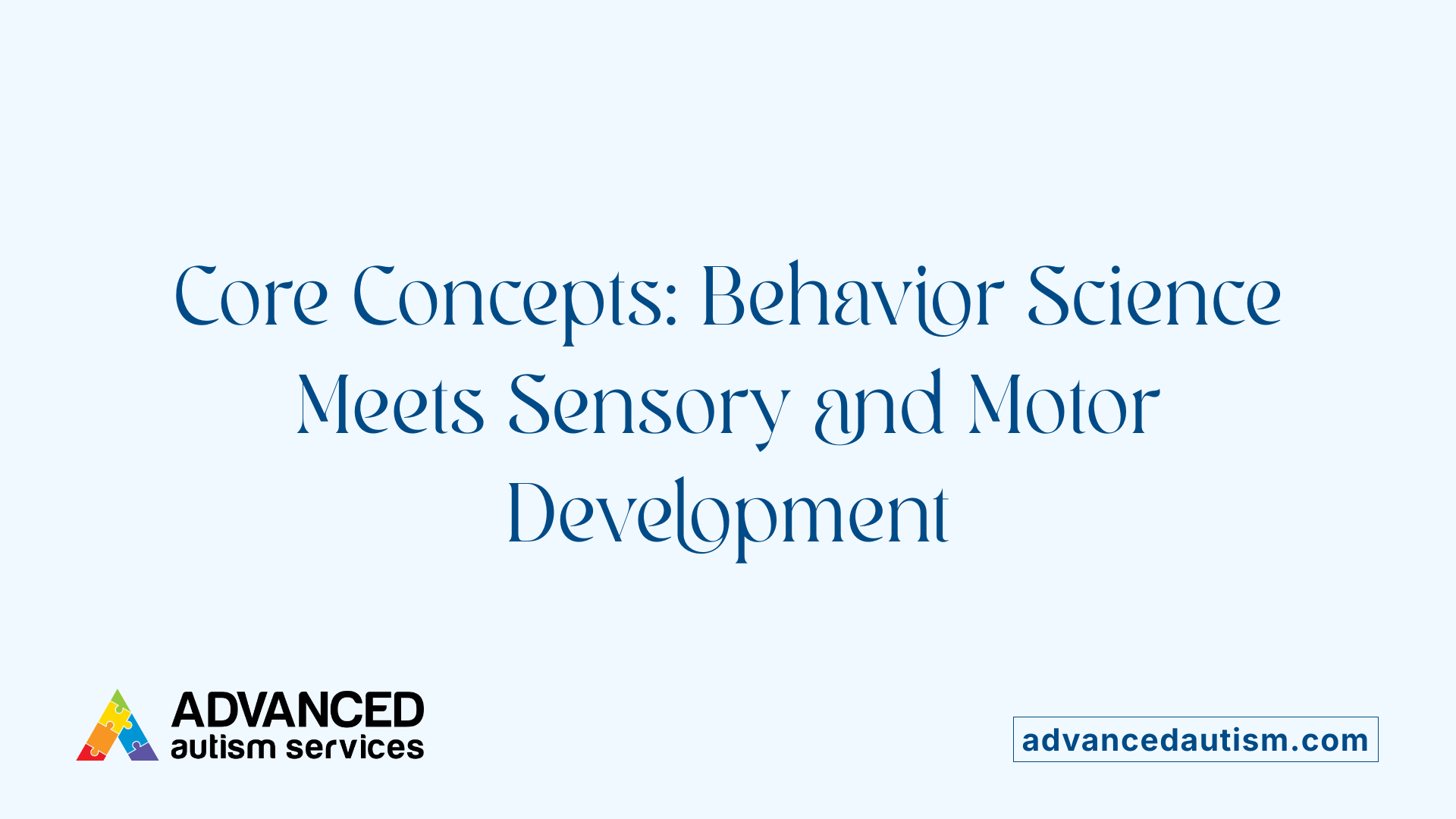
What are the foundational concepts of ABA and OT?
Applied Behavior Analysis (ABA) is a science-based approach grounded in behaviorism. It focuses on understanding how environmental factors influence behavior and uses this knowledge to modify and teach desirable behaviors through reinforcement. ABA involves detailed behavioral assessments, data collection, and the systematic implementation of interventions such as shaping, chaining, and discrete trial training. Its core emphasis is on changing behaviors that are socially significant, such as communication, social skills, and daily living skills.
Occupational Therapy (OT), on the other hand, is a holistic, client-centered profession devoted to helping individuals improve their ability to perform daily activities. It emphasizes sensory integration, motor skill development, self-care, and emotional regulation. OT assessments focus on motor abilities, sensory processing, and environmental influences, with tailored strategies like sensory play, adaptive techniques, and task analysis to promote independence.
What are the main goals of each therapy?
The principal aim of ABA is to increase positive behaviors and skills such as communication, social interactions, academic, and daily living tasks, while reducing problematic behaviors like aggression or self-injury. It seeks to develop meaningful, long-lasting change by skill acquisition and behavior management using techniques based on scientific evidence.
Occupational therapy strives to enhance functional independence by developing fine and gross motor skills, improving sensory processing capabilities, and fostering adaptive behaviors necessary for everyday life. Its wider goal is to enable children to participate fully and comfortably in their routines, social interactions, and environment.
Both therapies share the common objective of improving quality of life and fostering independence but approach these goals through different pathways—behavior modification versus functional skill development.
What are the key techniques used in ABA and OT?
In ABA, popular techniques include reinforcement strategies, shaping, chaining, task analysis, and discrete trial training. Positive reinforcement involves rewarding desired behaviors, thereby encouraging their repetition. Data collection is crucial for tracking progress and adjusting interventions.
Within occupational therapy, techniques include sensory integration activities, motor planning exercises, adaptive tool use, and play-based interventions. OT uses visual supports such as social stories and picture cues to enhance communication. Play acts as a central modality, making skill development engaging and meaningful.
Both therapies often utilize individualized approaches, breaking tasks into manageable steps, and incorporating reinforcement—whether through praise and natural rewards in OT or structured reward systems in ABA.
How can parents determine whether their child would benefit more from ABA Therapy or Occupational Therapy?
Parents can assess their child's specific needs by observing where the primary challenges lie. If your child demonstrates difficulties with managing behaviors, social engagement, or language, ABA therapy may be more suitable because of its structured, behavior-focused techniques. Particularly in higher levels of autism severity, ABA’s systematic approach can produce significant improvements.
Alternatively, if the main difficulties involve motor skills, sensory sensitivities, self-care routines, or adaptive daily activities, occupational therapy might be more beneficial. OT's focus on sensory processing, motor development, and environmental adaptations directly supports these skill areas.
In cases of Level 1 autism, where challenges in social skills and sensory experiences are prominent, OT can help improve participation and sensory regulation. For children with more severe autism, or those exhibiting significant behavioral challenges, ABA provides targeted strategies to develop communication, reduce problematic behaviors, and improve social functioning.
It's advisable for parents to seek comprehensive assessments by qualified healthcare professionals—including psychologists, occupational therapists, and behavioral analysts. Their evaluations can help chart a personalized pathway coupled with a tailored combination of both therapies if needed, maximizing developmental progress.
Distinct Methodologies and Techniques
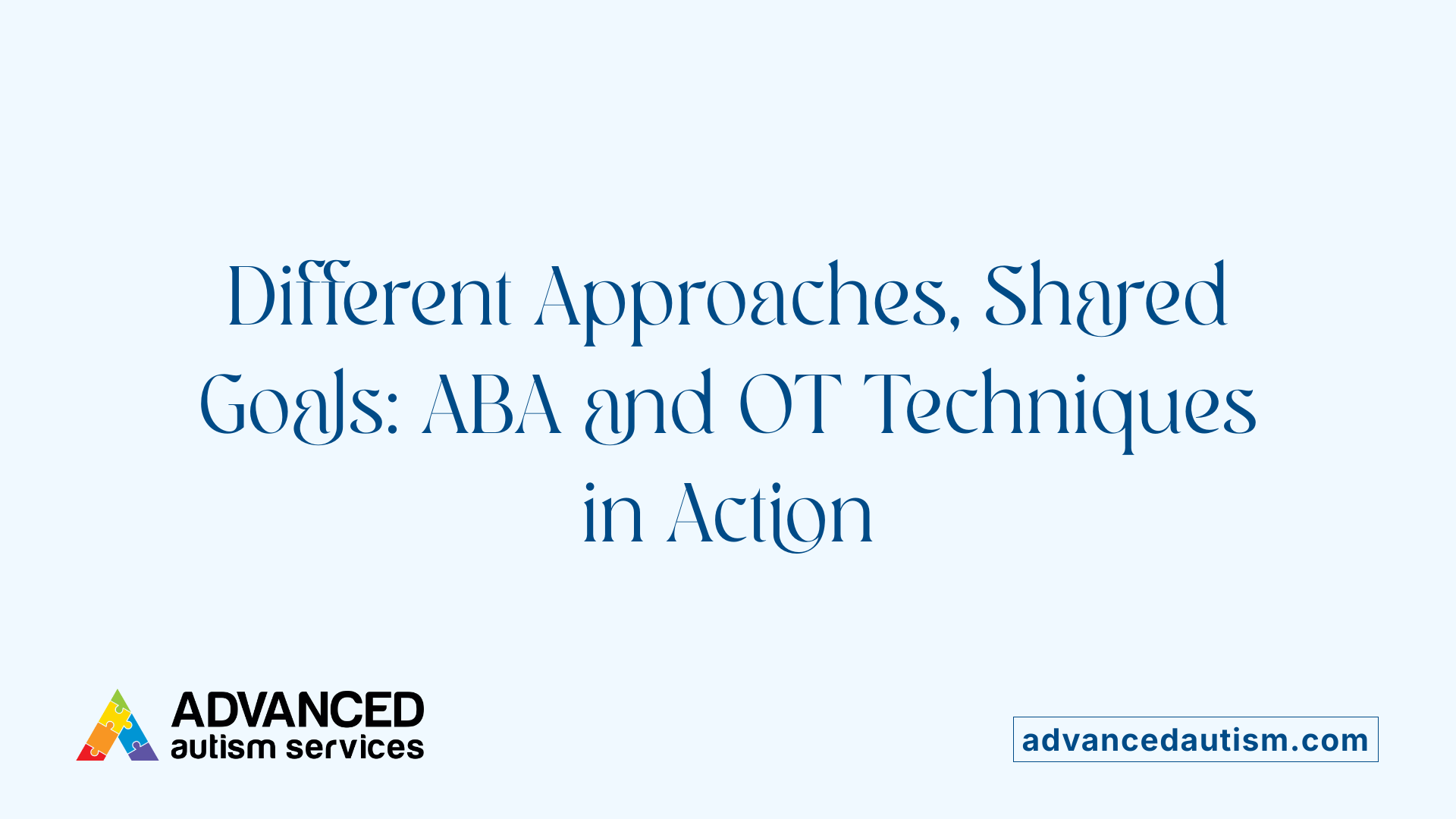
What are the main differences and similarities between ABA Therapy and Occupational Therapy?
ABA Therapy (Applied Behavior Analysis) and Occupational Therapy (OT) are two prominent interventions used to support children with autism spectrum disorder (ASD), but they employ different methods and focus on different skill areas.
ABA is a structured, scientific approach based on behaviorism. It aims to modify behavior, teach new skills, and reduce problematic behaviors through the use of reinforcement, data collection, and systematic interventions. Techniques such as discrete trial training, shaping, chaining, and positive reinforcement are common. ABA therapists focus on developing socially important skills like communication, social interaction, and daily living, while also addressing challenging behaviors such as aggression or self-injury.
In contrast, OT adopts a holistic, activity-based approach focused on enhancing functional independence. Occupational therapists work on developing or improving skills necessary for daily life, including fine and gross motor skills, sensory processing, self-care, emotional regulation, and social skills. They utilize play-based methods, sensory integration techniques, environmental modifications, and adaptive tools. OT often involves play routines that support motor coordination, sensory regulation, and social participation.
Similarities:
- Both aim to improve the child's quality of life and foster independence.
- They emphasize individualized treatment plans based on thorough assessments.
- Both can address overlapping developmental areas such as social skills and daily routines.
- They often work together in integrated treatment plans.
Differences:
- ABA is more data-driven, structured, and focused on behavior change, while OT is broader, emphasizing physical, sensory, and environmental factors.
- ABA employs techniques like shaping, chaining, and reinforcement explicitly targeting behavior modification.
- OT uses methods like sensory integration, play therapy, and environmental adaptations to support skill acquisition.
Ultimately, ABA therapy often involves intensive programs, sometimes up to 40 hours weekly, targeting specific behaviors and skills. In comparison, OT sessions are usually shorter in duration and focus more broadly on helping children participate actively and independently in daily life.
How do ABA and OT approaches to skill development differ?
ABA approaches skill development through systematic techniques that analyze interactions, identify triggers, and reinforce desired behaviors. Using tools like task analysis and reinforcement schedules, ABA builds skills step-by-step, with progress rigorously tracked through data. It often involves structured sessions with clear objectives, especially centered around communication, social behavior, and self-care.
OT, on the other hand, fosters skill development through play and sensory activities that naturally motivate children. OT interventions often have a client-centered focus, tailored to each child's unique sensory profile, motor abilities, and daily routines. Skills are developed through meaningful activities, with emphasis on sensory integration, motor planning, and environmental adaptations.
Both therapies recognize the importance of breaking complex tasks into smaller, manageable steps but differ in their application—ABA relies heavily on reinforcement and repetition in a controlled environment, whereas OT promotes learning through functional play, exploration, and sensory-motor experiences.
Techniques Used in Each Therapy
| Technique | Used By | Purpose | Example Activity |
|---|---|---|---|
| Discrete Trial Training | ABA | Teaching specific skills through structured, repeated trials | Teaching new words through repeated prompts |
| Shaping | ABA | Reinforcing successive approximations to target behavior | Reinforcing partial movements toward a goal |
| Chaining | ABA | Linking individual steps into a complete task | Teaching dressing by training each step separately |
| Positive Reinforcement | ABA | Encouraging desired behaviors | Giving praise or tokens for communication |
| Sensory Integration | OT | Regulating sensory processing | Swings, brushing routines |
| Play-Based Skill Development | OT | Enhancing motor and social skills | Role-playing, obstacle courses |
| Environmental Modifications | OT | Supporting independence | Installing grab bars or visual schedules |
How Each Therapy Approaches Skill Development
ABA systematically teaches skills by analyzing behavior, identifying triggers, and designing tailored interventions that promote positive behaviors. It often involves repetitive practice, data collection, and reinforcement to ensure mastery.
OT facilitates skill development through naturalistic activities and sensory experiences that promote motivation and generalization of skills. Play is central, with the goal of making learning engaging and meaningful, often involving adaptation of the environment and tools.
While their methods differ, both approaches are effective and can complement each other in a comprehensive intervention plan. Combining the structured behavior strategies of ABA with the sensory and functional focus of OT often results in better overall outcomes for children with autism.
This synergy leverages ABA’s strength in behavior change and skill acquisition with OT's focus on sensory integration and practical independence, offering a well-rounded support system tailored to each child’s unique needs.
Applications and Benefits
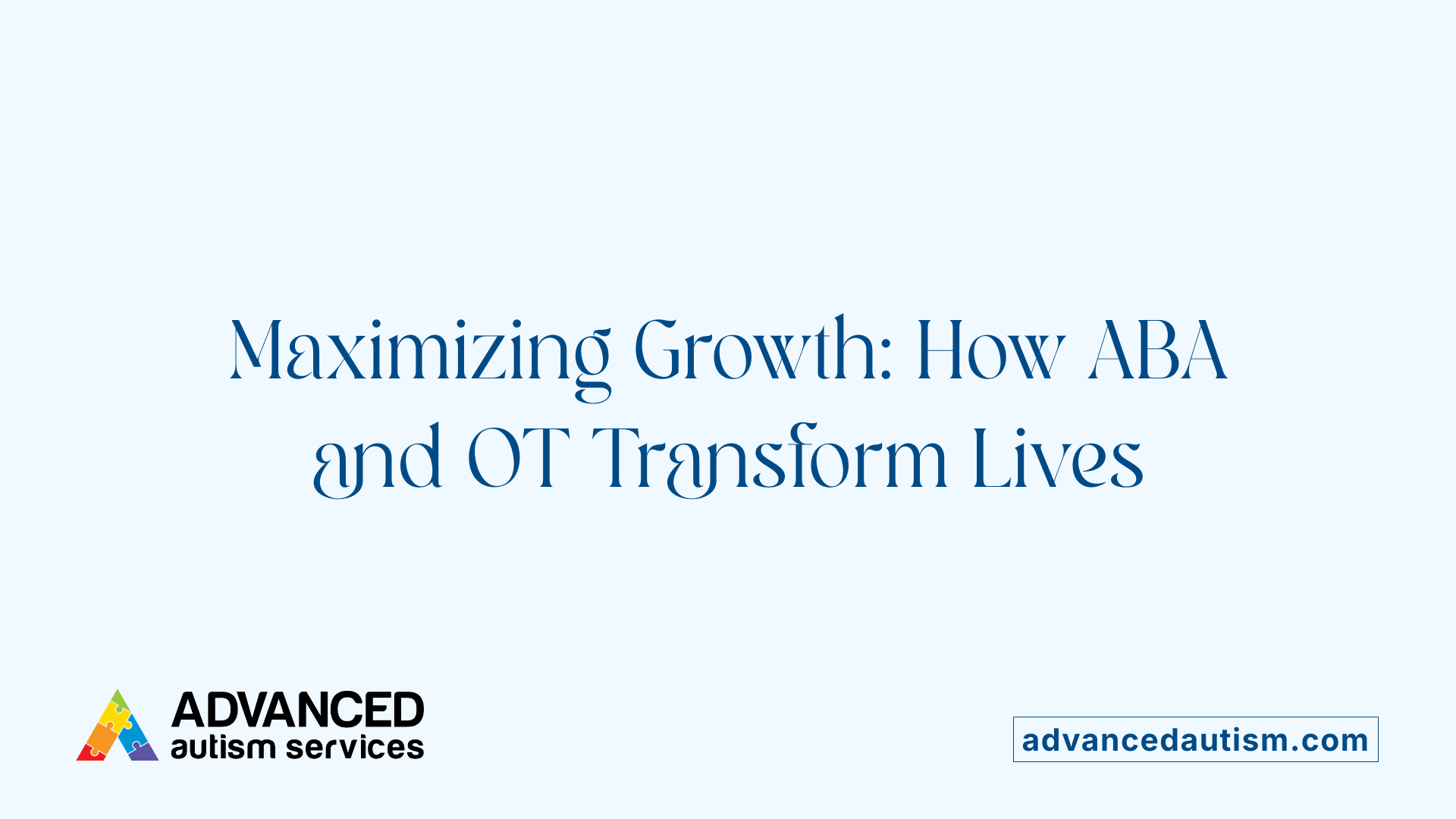
How each therapy supports children with autism
Occupational Therapy (OT) and Applied Behavior Analysis (ABA) are two prominent approaches used to support children with autism spectrum disorder (ASD). OT focuses on developing essential life skills, addressing sensory processing issues, and improving motor coordination. It emphasizes helping children gain independence in daily activities such as dressing, self-care, and social interactions through play-based and sensory integration techniques.
ABA therapy, on the other hand, is rooted in behavioral science and aims to modify problematic behaviors and teach new, socially important skills. It uses reinforcement strategies, discrete trial training, and data-driven assessments to improve communication, social interaction, and adaptive functioning. While OT often deals with physical and sensory development, ABA targets behavior modification with a structured, systematic approach.
Both therapies support children’s overall development, often complementing each other in practice. Combining their efforts can enhance social skills, emotional regulation, and daily independence, laying a strong foundation for long-term growth.
Specific interventions and their outcomes
OT-specific interventions
- Sensory integration activities to manage sensory sensitivities
- Hand-eye coordination exercises to improve fine motor skills
- Play-based routines to teach self-care tasks like dressing and eating
- Use of adaptive tools and environmental modifications to enhance participation
Outcomes: Improved sensory processing, better motor coordination, increased independence in daily routines, and enhanced social participation.
ABA-specific interventions
- Reinforcement of positive behaviors related to communication and social skills
- Discrete trial training to teach imitation, language, and social responses
- Behavior tracking to identify triggers of challenging behaviors
- Use of visual supports and social stories to facilitate understanding
Outcomes: Reduction in challenging behaviors (e.g., aggression, self-injury), improved language and cognitive skills, better social interaction, and increased adaptive skills.
Evidence supporting the effectiveness of each therapy
Many studies and clinical reviews support the positive impact of both OT and ABA. Research consistently shows that ABA results in meaningful improvements in communication, social behaviors, and daily life skills, especially when applied early and intensively. The U.S. Surgeon General endorses ABA as an effective, research-backed methodology.
Occupational therapy also has a strong evidence base, demonstrating success in enhancing sensory integration, motor skills, and self-care abilities. Its holistic, client-centered approach aligns well with evidence suggesting that addressing sensory and physical challenges can significantly improve overall functioning.
Despite their proven benefits, ABA is often underrepresented in occupational therapy literature, which tends to focus on developmental and sensory strategies. Nonetheless, the potential for synergy between these approaches is widely recognized, encouraging collaborative interventions.
Summary Table of Interventions and Outcomes
| Therapy | Intervention Techniques | Main Outcomes | Evidence Base |
|---|---|---|---|
| Occupational Therapy | Sensory integration, motor exercises, environmental modifications, play-based activities | Improved sensory processing, motor skills, independence in daily routines | Strong clinical evidence, endorsed by health authorities |
| ABA Therapy | Reinforcement, discrete trial training, social stories, functional behavior assessments | Reduced problematic behaviors, improved communication and social skills | Extensive research validation, endorsed by U.S. Surgeon General |
Both therapies are individualized, starting with comprehensive assessments, followed by goal setting, tailored interventions, and ongoing progress monitoring. A combined approach can optimize developmental outcomes, making use of each therapy's strengths to foster independence and well-being.
Assessment Methods and Tailored Interventions
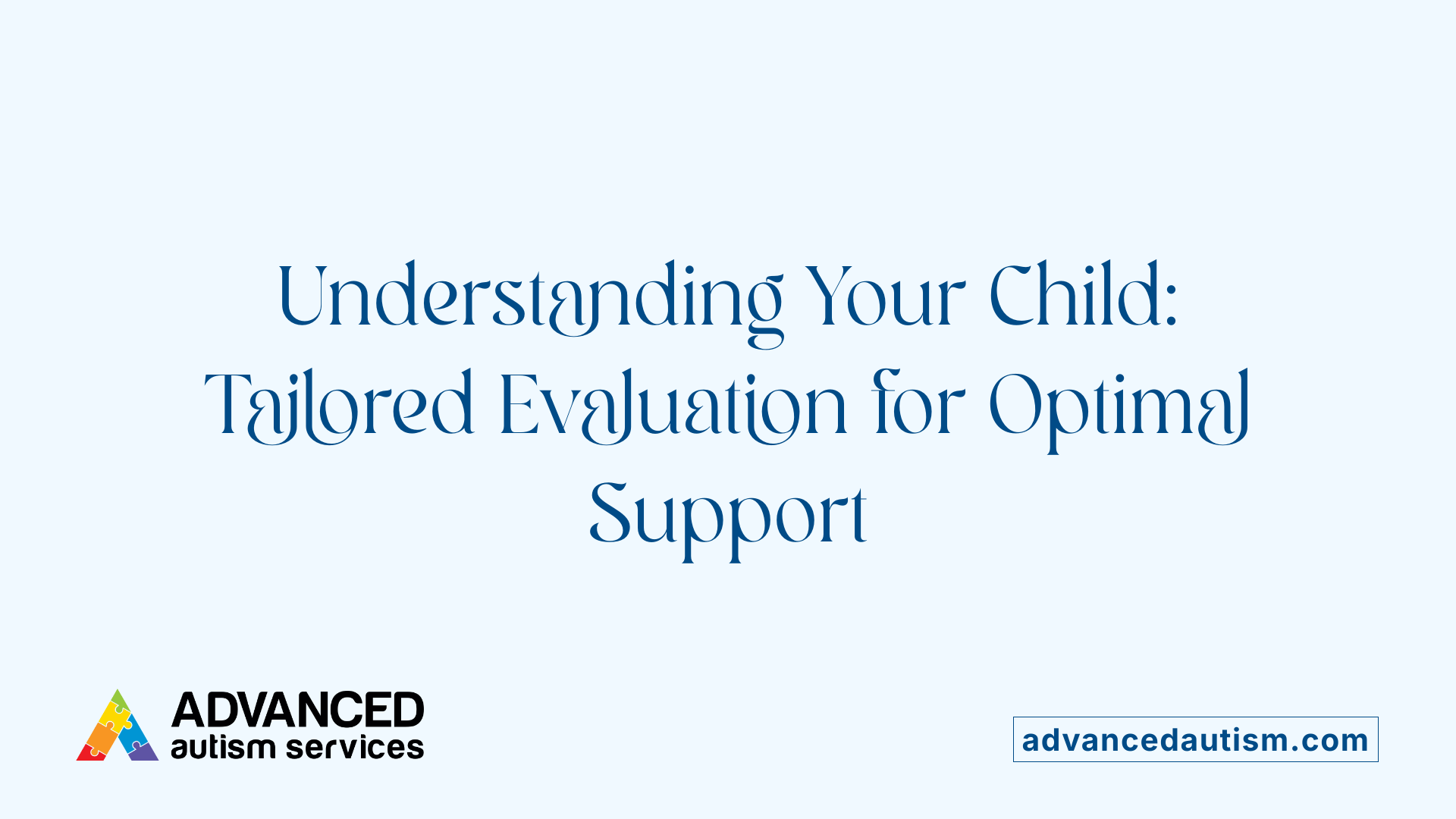
What are the typical assessment methods used to determine the appropriateness of ABA Therapy and Occupational Therapy?
Determining whether ABA or OT is suitable for a child involves a variety of assessment tools and procedures. Both therapies rely on detailed evaluations to understand the child's unique strengths, challenges, and developmental profile.
For ABA therapy, a primary assessment method is the Functional Behavioral Assessment (FBA). FBAs analyze specific behaviors, their frequency, triggers, and environmental factors. This detailed analysis helps therapists develop personalized behavioral intervention plans, focusing on reducing problematic behaviors and teaching new skills.
In addition, ABA practitioners conduct skill assessments that evaluate communication, social interaction, daily living skills, and flexibility. These assessments include direct observations and structured interviews, often complemented by tools like the VB-MAPP or ABLES, which provide a developmental picture aligned with behavioral goals.
Occupational therapy assessments focus on different domains, such as motor skills, sensory processing, and functional independence. Standardized tools like the Sensory Profile, the Vineland Adaptive Behavior Scales, and the Peabody Developmental Motor Scales are commonly used to measure sensory integration and motor functioning.
For autism spectrum disorder diagnosis and characterization, tools such as the Autism Diagnostic Observation Schedule (ADOS), Autism Diagnostic Interview-Revised (ADI-R), Disability Interview and Screening Checklist (DISCO), and Childhood Autism Rating Scale 2 (CARS-2) are employed. These comprehensive tools gather information from caregivers and professionals through interviews, observations, and questionnaires, ensuring a thorough understanding of the child's behavioral and developmental profile.
Assessment methods also include developmental evaluations that identify milestones in cognitive, language, and social domains. These evaluations help set realistic intervention goals and determine intervention intensity.
How assessments inform treatment planning
The detailed results from these assessments enable clinicians to create highly individualized treatment plans. For example, if an assessment reveals sensory sensitivities, the OT can incorporate sensory integration techniques tailored to the child's specific needs. Similarly, if the child demonstrates challenging behaviors triggered by certain situations, the ABA team designs strategies that include reinforcement techniques and behavior modification steps.
Assessment data also guide the setting of achievable goals, help prioritize specific skill areas, and determine the appropriate frequency and type of interventions. Continuous monitoring and re-assessment ensure that treatment remains aligned with the child's evolving needs.
Examples of personalized goals
Personalized goals may include increasing communicative gestures or verbalizations, improving self-care routines such as dressing or bathing, reducing agitation or aggression, enhancing motor coordination, and fostering social participation during play.
For example, a goal set after an assessment might be, "Child will demonstrate the ability to independently brush teeth with minimal prompts within three months," or, "Child will use at least three different words to request preferred items during therapy sessions."
By tailoring interventions to these individualized goals, therapists can optimize progress and promote the child's independence and quality of life.
Integrating ABA and OT for Holistic Support
How can therapies such as ABA and OT complement each other?
Both Applied Behavior Analysis (ABA) and Occupational Therapy (OT) serve distinct yet overlapping roles in supporting children with autism spectrum disorder. ABA is a structured, data-driven approach emphasizing behavior modification through reinforcement, skill learning, and reducing challenging behaviors. OT, on the other hand, takes a holistic, sensory-based approach focusing on daily life skills, motor coordination, sensory processing, and emotional regulation.
When combined, these therapies address a broad spectrum of developmental needs. ABA can effectively develop social, communication, and behavioral skills through techniques like discrete trial training and reinforcement. Meanwhile, OT can enhance sensory integration, fine and gross motor skills, and self-care routines via play-based strategies and environmental modifications.
Their integration fosters a synergistic effect where improvements in sensory processing and motor abilities support ABA's behavioral learning, and behavioral strategies can reinforce the skills developed through OT. Coordination between therapists and active family involvement ensure interventions are cohesive and tailored to each child's unique profile.
What are the benefits of combining ABA and OT?
Combining ABA and OT offers several advantages:
- Holistic Development: Addresses physical, emotional, social, and behavioral aspects of growth.
- Faster Skill Acquisition: Simultaneous focus on multiple developmental areas accelerates progress.
- Better Generalization: Skills learned in therapy are more likely to transfer across settings.
- Enhanced Independence: Skills targeted include daily living, communication, and social interactions.
- Reduced Challenging Behaviors: ABA strategies can help manage behaviors rooted in sensory sensitivities, which OT can also address.
- Family Support: Integrated plans promote consistency across routines and environments at home, school, and therapy settings.
Research supports that children who receive combined services tend to show more comprehensive gains and maintain progress longer.
What strategies support coordinated intervention?
Effective integration involves strategic collaboration among therapists, families, and educators:
- Joint Planning: Regular meetings to set shared goals focusing on behavior, sensory, motor, and social skills.
- Shared Assessments: Using comprehensive evaluations to inform both behavioral and sensory/motor interventions.
- Consistent Techniques: Applying reinforcement strategies and sensory strategies across therapies to maximize learning.
- Parallel Sessions: Scheduling therapy sessions close in time or integrating activities to facilitate skill transfer.
- Parent Training: Educating families on intervention strategies from both disciplines to reinforce skills at home.
- Data Sharing: Using consistent tracking tools to monitor progress and adjust goals dynamically.
This coordinated approach not only improves outcomes but also creates a supportive environment that nurtures the child’s overall growth.
| Aspect | ABA Approach | OT Approach | Synergy |
|---|---|---|---|
| Focus | Behavior modification, social skills, communication | Sensory processing, motor skills, daily routines | Addressing behaviors through sensory support and skill development |
| Techniques | Reinforcement, discrete trial, shaping | Sensory integration, play-based, environmental adaptations | Combined techniques create comprehensive skill building |
| Goal Outcomes | Improved social/behavioral skills, independence | Motor coordination, self-care, sensory regulation | Well-rounded development within daily life routines |
| Implementation Strategies | Data collection, individualized plans, reinforcement | Practical activities, sensory tools, environmental modifications | Cohesive interventions across environments |
Can ABA and Occupational Therapy be delivered together, and how does this benefit individuals with autism?
Yes, ABA therapy and occupational therapy can be delivered simultaneously, often providing synergistic benefits for individuals with autism. Combining these therapies allows for a more comprehensive approach that targets both behavioral challenges and developmental skills essential for independence.
ABA primarily focuses on modifying behaviors, teaching social and communication skills, and reducing problematic actions through structured routines and reinforcement. OT complements this by addressing underlying sensory sensitivities, enhancing motor abilities, and promoting self-care and emotional regulation.
This dual approach encourages consistent skill reinforcement across all environments, leading to faster progress and greater maintenance of gains. It also ensures that behavioral strategies are supported by sensory regulation and motor skill development, creating a foundation for broader social learning and independence.
Collaborative efforts among therapists, families, and educators ensure interventions are tailored, coordinated, and efficient, ultimately improving the child's overall well-being and capabilities.
In summary, integrating ABA and OT maximizes developmental potential, provides balanced support for complex needs, and promotes a better quality of life for children with autism.
Addressing Concerns and Ethical Considerations
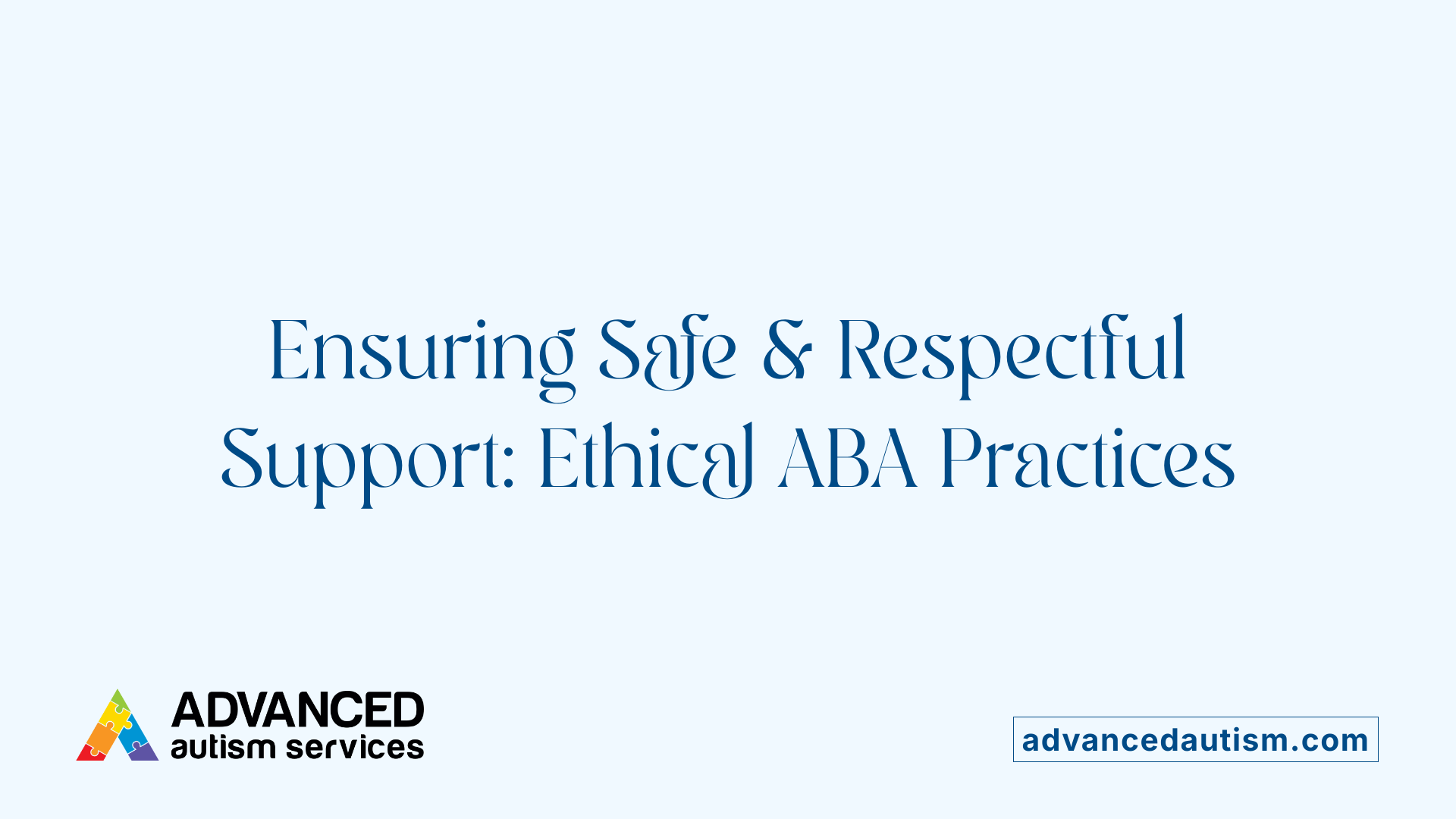
Are there any concerns regarding the harm or effectiveness of ABA Therapy?
While Applied Behavior Analysis (ABA) is backed by strong research and is considered effective for developing skills in children with autism, it is not without concerns. Some critics highlight the potential risks of misuse or overly rigid application of ABA techniques.
One major worry is the possibility of emotional distress or trauma. When ABA is delivered in a highly intensive or punitive manner, it can cause anxiety, frustration, or feelings of helplessness. Such practices may also push children to mask their natural behaviors, including stimming, which can negatively impact their mental health.
Additionally, some advocates and self-advocates argue that traditional ABA approaches, especially in the past, prioritized conformity over individual well-being. This has led to concerns that the therapy might suppress important autistic traits or personal expressions, rather than support genuine acceptance.
Modern, ethical ABA practices aim to minimize these risks by focusing on positive reinforcement, naturalistic teaching strategies, and respecting each child's unique autistic traits. This person-centered approach emphasizes collaboration and choice, ensuring interventions are supportive rather than coercive.
When delivered responsibly by trained professionals, ABA can significantly improve communication, social skills, and independence. However, improper implementation—such as using excessive or aversive techniques—can cause emotional and psychological harm.
To ensure safe and effective treatment, it is vital for families to choose qualified providers who adhere to ethical standards. Ongoing assessment, transparency, and focus on the child's comfort and preferences are crucial components of responsible ABA therapy.
Ultimately, balancing evidence-based practices with respect for individual differences and well-being is essential in addressing potential concerns and maximizing the benefits of ABA.
Choosing the Best Approach for Your Child's Future
In summary, both ABA therapy and occupational therapy play vital roles in supporting children with autism spectrum disorder. Understanding their core differences, methodologies, and applications helps parents make informed decisions tailored to their child's unique developmental profile. While ABA is highly effective in behavior modification and skill acquisition, OT provides essential support for sensory, motor, and daily living skills. When combined thoughtfully, these therapies can create a comprehensive, personalized intervention plan that fosters independence, enhances social participation, and improves overall quality of life. Consulting with multidisciplinary professionals and regularly assessing progress ensures the chosen therapies align with the child's evolving needs. Ultimately, prioritizing ethical, evidence-based, and child-centered approaches will optimize outcomes and help children with autism reach their full potential.
References
- Occupational Therapy vs ABA: 4 Key Differences
- Applied Behavior Analysis (ABA) Therapy vs. Occupational Therapy
- Applied Behavior Analysis, Autism, and Occupational Therapy
- ABA therapy vs occupational therapy - Ability Innovations
- Occupational Therapy vs. ABA Therapy – What's the Difference?
- OT, PT, Speech vs. ABA: Early Intervention | MPG
- The Difference Between ABA Therapy and Occupational Therapy
- Occupational Therapy vs. Applied Behavior Analysis
- When to Combine Occupational Therapy and ABA for Children



